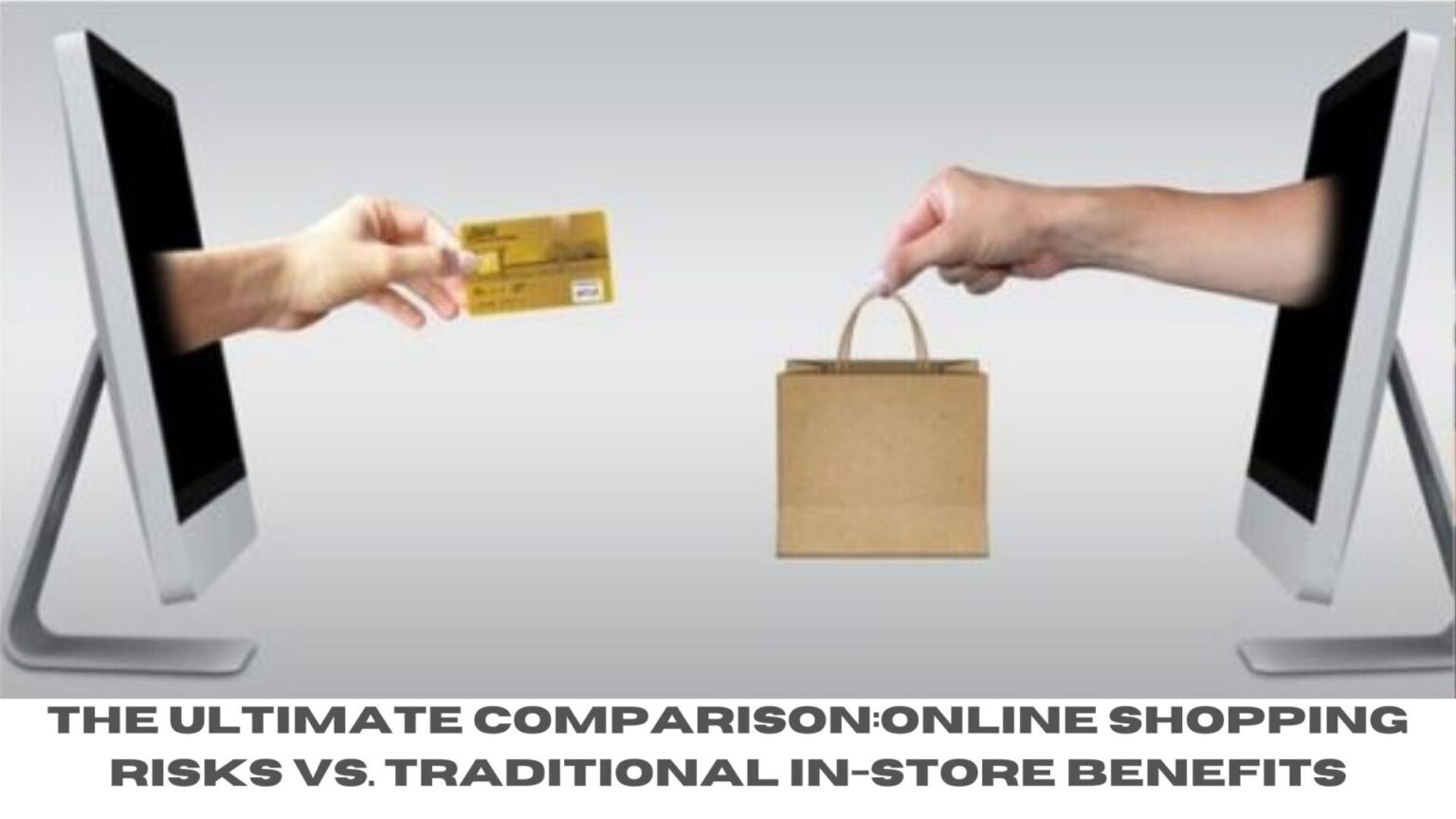Introduction:-
Navigating Choices: A Comprehensive Comparison of Online Shopping Risks and Traditional In-Store Benefits

In an era dominated by digital convenience, online shopping has become a ubiquitous part of our lives. However, is the allure of virtual carts and doorstep deliveries overshadowing the tangible advantages offered by in-store shopping? Let’s embark on an insightful journey to compare the risks inherent in online transactions with the enduring benefits of the traditional in-store model.
Online Shopping Risks vs. Traditional In-Store Benefits
The Pros and Cons of Online Shopping Risks
Convenience at a Cost
While online shopping dazzles with its unmatched convenience, it comes with its own set of risks. From cybersecurity concerns to the uncertainty of product quality, buyers tread a virtual tightrope. This section explores the potential pitfalls and equips readers with the knowledge needed to navigate the online shopping landscape safely.
The Allure of Endless Choices
Online platforms boast an extensive array of products, promising endless choices at the click of a button. However, the abundance of options can be overwhelming, leading to decision fatigue. We dissect this aspect, helping readers understand the fine line between variety and the paradox of choice.
The Convenience of Doorstep Delivery
One of the main draws of online shopping is the luxury of doorstep delivery. But, is this convenience a double-edged sword? We explore the hidden costs of free home delivery, from environmental concerns to the impact on local businesses, urging consumers to weigh the price of convenience.
The Timeless Charm of In-Store Shopping
Tangible Experiences and Personal Interaction
In-store shopping provides a sensory experience that online platforms struggle to replicate. Touching, feeling, and trying products create a tangible connection. This section extols the virtues of personal interaction with products and knowledgeable staff, emphasizing the value of the in-store shopping experience.
Instant Gratification: Taking It Home Today
Unlike the waiting game of online deliveries, in-store purchases offer the immediate satisfaction of taking the chosen item home. We explore the psychological impact of instant gratification and how it adds an invaluable dimension to traditional shopping.
Building Trust: The Inherent Reliability of In-Store Transactions
In an age where online scams and fraud are prevalent, in-store transactions are perceived as a safer bet. We dissect the trust factor associated with in-store purchases, discussing the role of face-to-face interactions and the security that comes with physically inspecting and paying for products.
What are the biggest reasons people shop online?
Several factors contribute to the popularity of online shopping, and the biggest reasons people shop online include:

- Convenience: Online shopping provides the ultimate convenience, allowing consumers to shop from the comfort of their homes or on-the-go using smartphones and other devices. The 24/7 accessibility of online stores eliminates the need to adhere to traditional store hours, making it easy for people to browse and make purchases at their convenience.
- Wide Selection: Online retailers offer a vast array of products from various brands and sellers. This extensive selection allows shoppers to find specific items, compare prices, and explore different options without the constraints of physical store space. The variety available online is often greater than what is found in brick-and-mortar stores, offering consumers more choices.
- Price Comparison: Online platforms enable users to easily compare prices across different sellers, helping them find the best deals and discounts. Price transparency is a significant advantage for consumers, allowing them to make informed purchasing decisions and potentially save money.
- Access to Reviews and Ratings: Online shopping platforms provide access to customer reviews and product ratings. Shoppers can read about the experiences of others who have purchased the same or similar items, helping them make informed decisions about product quality, features, and suitability.
- Time-Saving: Online shopping eliminates the need for travel to physical stores, saving time and energy. With a few clicks, consumers can find, order, and pay for products, avoiding the time-consuming aspects of traditional shopping, such as commuting, searching for parking, and navigating through crowded stores.
- Home Delivery and Shipping Options: The convenience of home delivery is a major draw for online shoppers. Many online retailers offer fast and reliable shipping options, and some provide free or discounted shipping, making it easy for consumers to receive their purchases directly at their doorstep.
- Exclusive Deals and Discounts: Online shopping platforms frequently offer exclusive deals, discounts, and promotions. This attracts price-conscious shoppers looking for cost-effective options and special offers that may not be available in physical stores.
- Easier Comparison Shopping: Online shoppers can easily compare products and prices across multiple websites, allowing them to find the best value for their money. This level of comparison shopping is often more challenging to achieve in traditional brick-and-mortar stores.
- Personalized Recommendations: Many online retailers use algorithms to analyze a shopper’s preferences and behavior, providing personalized product recommendations. This tailored shopping experience enhances user satisfaction and helps individuals discover products they may not have found otherwise.
- Accessibility and Inclusivity: Online shopping breaks down geographical barriers, enabling consumers to access products from around the world. This is particularly beneficial for individuals living in remote areas or those seeking unique items not available locally. Additionally, online shopping is accessible to individuals with mobility challenges or those who may find it difficult to visit physical stores.
These reasons collectively contribute to the growing trend of online shopping and its widespread adoption by consumers globally.
Conclusion: Striking the Right Balance
As we unravel the intricacies of online shopping risks and traditional in-store benefits, readers are empowered to make informed choices that align with their preferences and values. Whether embracing the ease of online transactions or relishing the timeless charm of in-store shopping, finding the right balance is key to a satisfying and secure consumer experience.
FAQs: Online Shopping Risks vs. Traditional In-Store Benefits
Online Shopping Risks
Q1: What are the main risks associated with online shopping?
A1: The main risks of online shopping include:
- Security Risks: Potential for data breaches, identity theft, and fraud.
- Product Quality: Risk of receiving items that do not match the description or are of poor quality.
- Shipping Issues: Delays, lost packages, or items damaged in transit.
- Return Complications: Difficulty in returning or exchanging items, and potential for non-refundable items.
- Hidden Costs: Unexpected shipping fees, taxes, or customs duties.
Q2: How can I protect myself from online shopping fraud?
A2: To protect against online shopping fraud:
- Use secure payment methods (like credit cards or trusted payment services).
- Shop from reputable websites and check for security certificates (HTTPS).
- Avoid public Wi-Fi for transactions.
- Keep your computer and software updated.
- Regularly monitor your bank statements for unauthorized charges.
Q3: Are there privacy concerns with online shopping?
A3: Yes, online shopping often requires sharing personal information, which can be vulnerable to data breaches or misuse by companies. Using strong passwords, two-factor authentication, and shopping from trusted sites can mitigate some of these concerns.
Traditional In-Store Benefits
Q4: What are the advantages of shopping in physical stores? A4: Advantages of in-store shopping include:
- Immediate Gratification: You can take the items home immediately.
- Product Inspection: Ability to see, touch, and try products before purchasing.
- Customer Service: Direct assistance from sales staff.
- Returns and Exchanges: Often easier and faster in person.
- No Shipping Costs: No need to pay for shipping or wait for delivery.
Q5: How does in-store shopping enhance the shopping experience? A5: In-store shopping can be more engaging and satisfying due to the ability to physically interact with products, receive personalized service, and enjoy the ambiance of the store.
Q6: Are there any financial benefits to in-store shopping? A6: Yes, in-store shopping can sometimes offer better deals through in-store promotions, clearance sales, and the ability to avoid shipping fees.
Comparing Online and In-Store Shopping
Q7: Which is more cost-effective, online shopping or traditional shopping? A7: It depends on various factors. Online shopping may offer better deals and wider selections, but it can also come with shipping fees and the risk of hidden costs. In-store shopping can save on shipping fees and may offer immediate sales or discounts.
Q8: What is more convenient, online or in-store shopping? A8: Online shopping is generally more convenient as it can be done from anywhere at any time, but in-store shopping provides immediate access to products and often better customer service.
Q9: How do the environmental impacts of online and in-store shopping compare? A9: Online shopping can have a larger carbon footprint due to packaging and shipping, while in-store shopping involves transportation to the store. However, the impact varies based on factors like shipping methods, packaging practices, and individual shopping habits.
References
- Security Risks and Protection:
- “Online Shopping: Risks and Precautions” – Consumer Reports
- “How to Shop Online Safely” – Norton Security
- Product Quality and Shipping Issues:
- “Online Shopping: Benefits and Risks You Need to Know” – Forbes
- “E-commerce: Handling Returns and Refunds” – Small Business Trends
- Customer Service and In-Store Experience:
- “Why Shopping in Physical Stores Will Never Go Out of Style” – Harvard Business Review
- “The Advantages of Shopping in Store vs. Online” – Retail Dive
- Environmental Impact:
- “Online Shopping and the Environment: What’s the Impact?” – The Guardian
- “How to Make Your Online Shopping More Sustainable” – National Geographic
These FAQs and references should provide a comprehensive overview of the key points regarding online shopping risks and traditional in-store shopping benefits.







Greetings! Very helpful advice in this particular post! It is the little changes that make the biggest changes.
Thanks a lot for sharing!
thanks a lot alan